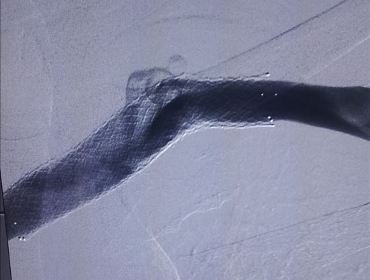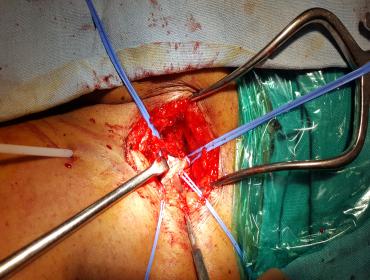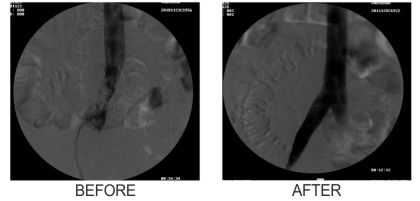Lymphatic System Disease (Swollen Leg) Treatmment
Swollen legs due to lymphatic and venous problems are treated by our vascular specialist.
The management options offered are:
- Catheter directed thrombolysis for Deep Vein Thrombosis (DVT)
- Pneumatic compression pumping for Lymph Edema
- Custom-made compression stockings
Swollen legs can be caused by a variety of factors, including but not limited to:
Systemic causes like heart failure, liver or kidney disease, Loco regional causes like blood clots, vein problems, or injury.
Leg swelling can be caused by a variety of factors, but some of the most common causes include:
Heart failure: When the heart is not able to pump blood effectively, fluid can build up in the legs and cause swelling.
Venous insufficiency: This is a condition where the veins in the legs are not able to pump blood back to the heart effectively, causing blood to pool in the legs and lead to swelling.
Blood clots: Blood clots can form in the legs and cause swelling, pain, and redness.
Liver or kidney disease: These conditions can lead to the buildup of fluid in the legs and cause swelling.
Injury: Trauma to the legs, such as a sprain or strain, can cause swelling.
It is important to see a Vascular and Endovascular specialist if you have persistent or worsening swelling in your legs, as it can be a sign of a more serious underlying condition.
Medicines that help the body get rid of too much fluid through urine can treat worse forms of edema. The best medicine for leg swelling depends on the underlying cause of the swelling. Some common treatments for leg swelling include:
Diuretics: Also known as “water pills,” these medications help the body get rid of excess fluid. They are often used to treat swelling caused by heart failure or liver disease.
Compression stockings: These are tight-fitting stockings that help improve circulation in the legs and reduce swelling.
Nonsteroidal anti-inflammatory drugs (NSAIDs): These are medications that can help reduce swelling and pain.
Anticoagulants: If the swelling is caused by a blood clot, anticoagulants may be prescribed to help prevent the clot from getting bigger.
Vasodilators: These are medications that help widen blood vessels and improve blood flow, which can help reduce swelling in the legs.
It is important to consult with a Vascular & Endovascular specialist doctor before starting any medication, as they will be able to determine the best treatment for your specific situation based on the underlying cause of the swelling.
There are several natural remedies that may help reduce swelling in the legs, including:
Elevation: Keeping your legs elevated above your heart can help reduce swelling by improving circulation.
Exercise: Gentle exercises, such as walking or swimming, can help improve circulation and reduce swelling in the legs.
Massage: Gently massaging the affected area can help improve circulation and reduce swelling.
Compression: Wearing compression stockings or using compression bandages can help improve circulation and reduce swelling.
Diet: Maintaining a diet low in salt can help reduce fluid retention and swelling in the legs.
Hydration: Drinking plenty of water can help reduce swelling by flushing out excess fluid from the body.
It is important to consult a specialist doctor before trying any natural remedies, especially if you have any underlying health conditions or are taking any other medications.
There are several things that can help reduce swelling quickly, including:
Elevation: Keeping the affected area elevated above the heart can help improve circulation and reduce swelling.
Ice: Applying a cold compress, such as a bag of ice or a frozen gel pack, can help reduce swelling and numb pain.
Compression: Wearing compression bandages or stockings can help improve circulation and reduce swelling.
Movement: Gentle exercises, such as walking or gentle stretching, can help improve circulation and reduce swelling
Massage: Gently massaging the affected area can help improve circulation and reduce swelling.
It is important to note that these remedies may only provide temporary relief and may not address the underlying cause of the swelling. If you have persistent or worsening swelling, it is important to see a vascular specialist doctor for a proper diagnosis and treatment.
Swelling can be a sign of a serious medical condition, and it is important to seek medical attention by consulting vascular specialist if:
The swelling is sudden and severe: If the swelling is accompanied by a rapid increase in size, redness, and warmth, it may be a sign of an infection, injury, or blood clot, and immediate medical attention is necessary.
The swelling is accompanied by other symptoms: If the swelling is accompanied by symptoms such as shortness of breath, chest pain, or difficulty breathing, it may be a sign of a serious condition, such as heart or lung problems, and requires immediate medical attention.
The swelling is in the legs and accompanied by pain: If the swelling is in the legs and is accompanied by pain, redness, warmth, or a feeling of tightness, it may be a sign of a blood clot and requires immediate medical attention.
The swelling does not go away: If the swelling does not go away after a few days, or if it continues to worsen, it may be a sign of a more serious underlying condition, and a doctor should be consulted.
Yes, swelling in the legs can sometimes be a sign of a serious underlying condition. Some possible causes of swelling in the legs include:
Deep vein thrombosis (DVT): This is a blood clot that forms in the deep veins of the leg, which can cause swelling, pain, and redness. DVT is a serious condition that can lead to complications such as pulmonary embolism (PE) if left untreated.
Chronic venous insufficiency: This is a condition in which the veins in the legs are unable to efficiently pump blood back to the heart, leading to swelling in the legs.
Heart failure: If the heart is unable to pump blood effectively, blood can back up in the veins, leading to swelling in the legs, ankles, and feet.
Liver disease: Swelling in the legs can be a sign of liver disease, as the liver plays a key role in controlling the balance of fluid in the body.
Kidney disease: If the kidneys are not functioning properly, excess fluid can build up in the body, leading to swelling in the legs, ankles, and feet.
If you are experiencing persistent or worsening swelling in your legs, it is important to see a vascular specialist for a proper diagnosis and treatment.
It is generally a good idea to see a vascular specialist if you are experiencing persistent or worsening swelling in your legs. While mild swelling in the legs may be due to simple causes, such as prolonged standing or sitting, it can also be a sign of a more serious underlying condition.
A doctor can perform a physical examination and order tests to determine the cause of the swelling. If necessary, the doctor can also prescribe medications, such as diuretics or compression stockings, to help reduce the swelling.
By seeing a vascular specialist, you can receive a proper diagnosis and treatment plan that is tailored to your specific needs and health history. Early treatment can help prevent the swelling from becoming more serious and can improve your quality of life.
In India, there are several treatment options available for swollen legs, including:
Medications: The doctor may prescribe diuretics, which help remove excess fluid from the body, or other medications to help reduce swelling.
Lifestyle changes: The doctor may recommend lifestyle changes, such as reducing salt intake, wearing compression stockings, and elevating the legs, to help reduce swelling.
Physical therapy: Physical therapy, such as massage and exercises, can help improve circulation and reduce swelling in the legs.
Pneumatic Compression Pump therapy: This involves less the external use of jackets with intermittent and sequential compression by air. This is especially useful for lymphatic edema. This treatment usually needs to be followed up with graduated compression stockings.
Surgery: In severe cases, surgery may be necessary to correct the underlying cause of the swelling, such as to remove a blood clot or to treat a damaged vein.
Home remedies: The doctor may also suggest home remedies, such as elevating the legs, exercising, and using ice packs, to help reduce swelling.
The specific treatment plan will depend on the underlying cause of the swelling and the severity of the condition. It is important to follow the advice and treatment plan recommended by your doctor to ensure the best possible outcome.
Gallery


Subclavian Vein Stent

Endophlebectomy
Successful Treatments






